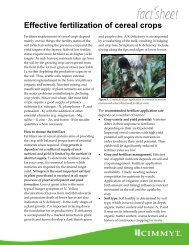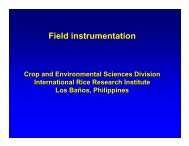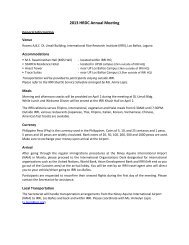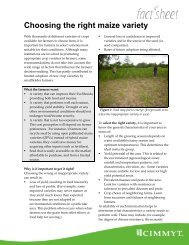Water management in irrigated rice - Rice Knowledge Bank ...
Water management in irrigated rice - Rice Knowledge Bank ...
Water management in irrigated rice - Rice Knowledge Bank ...
- No tags were found...
You also want an ePaper? Increase the reach of your titles
YUMPU automatically turns print PDFs into web optimized ePapers that Google loves.
Table 5.1. Area, water use, and total production of flooded <strong>rice</strong> and of <strong>rice</strong> grown under AWD, <strong>in</strong> ahypothetical irrigation scheme of 10,000 ha with 134 10 6 m 3 of water available.Land use Area (ha) <strong>Water</strong> use (10 6 m 3 ) Production (tons)Scenario I (80% farmers, flooded <strong>rice</strong>; 20% farmers, no crop)Flooded 8,000 134 46,400AWD 0 0 0Fallow 2,000 0 0Sum 10,000 134 46,400Scenario II (65% of farmers, flooded <strong>rice</strong>; 35% farmers, AWD)Flooded 6,560 110 38,048AWD 3,440 24 14,852Fallow 0 0 0Sum 10,000 134 52,900Table 5.2. Yield, water productivity with respect to total water <strong>in</strong>put (WP IR), and water <strong>in</strong>put of flooded<strong>rice</strong> and <strong>rice</strong> grown under AWD (from Table 3.2, Guimba 1989).Yield (t ha −1 ) WP IR(kg m −3 ) <strong>Water</strong> use (m 3 ha −1 )Flooded 5.8 0.345 1,679AWD 4.3 0.614 700Table 5.3. Area under <strong>rice</strong> production, and total water use, <strong>rice</strong> production, and number of farmers,with flooded <strong>rice</strong> and with AWD as design criteria.Design criterion<strong>Rice</strong> area <strong>Water</strong> use Production Farmers(ha) (10 6 m 3 ) (tons) (number)Flooded 10,000 168 58,000 10,000AWD 23,986 168 103,000 23,986but illustrates the effect of <strong>in</strong>clud<strong>in</strong>g the conceptof water productivity (besides yield) <strong>in</strong> irrigationsystem <strong>management</strong>.5.5 Irrigation system designAWD irrigation can be taken as a start<strong>in</strong>g po<strong>in</strong>t <strong>in</strong>the design of a new irrigation system. Suppose thata hypothetical reservoir can be constructed with acapacity of 168 10 6 m 3 , and that a command areawill be designed for <strong>rice</strong> farmers gett<strong>in</strong>g 1 ha each.If AWD irrigation is the design criterion ratherthan flooded <strong>rice</strong>, the <strong>irrigated</strong> <strong>rice</strong> area and total<strong>rice</strong> production are larger, and more farmers willbenefit from irrigation development (Table 5.3).If reuse of percolation and dra<strong>in</strong>age water is taken<strong>in</strong>to consideration <strong>in</strong> the design, the <strong>rice</strong> area underirrigation can <strong>in</strong>crease further <strong>in</strong> both scenarios.With 100% reuse of water, the <strong>irrigated</strong> <strong>rice</strong> areaswould be similar <strong>in</strong> both scenarios s<strong>in</strong>ce AWDmostly saves water by reduc<strong>in</strong>g percolation flows(that can be reused) and only a little by reduc<strong>in</strong>gevaporation (which cannot be reduced). However,100% water reuse is <strong>in</strong> practice not atta<strong>in</strong>able andthe implementation of AWD would lead to thelargest area under irrigation.This example demonstrates the impact thatwater-sav<strong>in</strong>g technologies can have on irrigationsystem design. Rather than tak<strong>in</strong>g cont<strong>in</strong>uous flood<strong>in</strong>gof fields as a design criterion, a rotation of waterdelivery can be used that is designed to let the fieldsdry out for a few days dur<strong>in</strong>g each rotation cycle.43





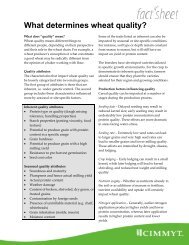

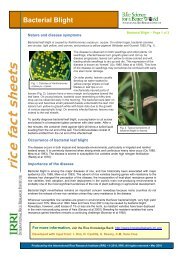

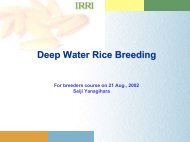
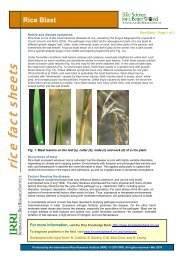
![International Standards' Organization â Rice Specification [ISO 7301]](https://img.yumpu.com/36696862/1/190x245/international-standards-organization-a-rice-specification-iso-7301.jpg?quality=85)

